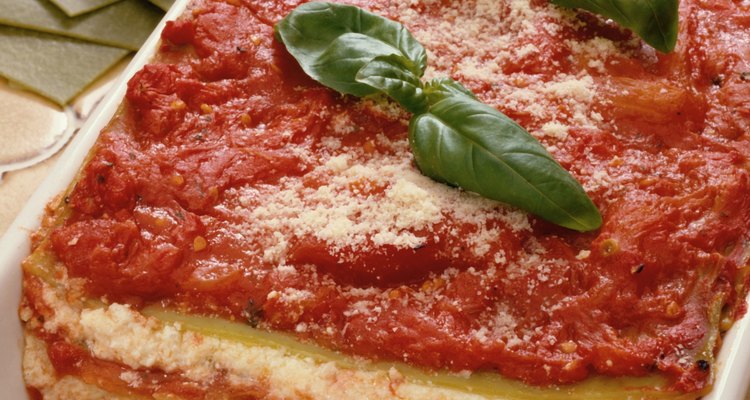
Jupiterimages/Photos.com/Getty Images
With its bright, milky flavor, queso fresco is a delicious accompaniment to a heavy dish such as lasagna. Much like ricotta, this fresh, Mexican cheese is unaged and has a light, somewhat crumbly texture. In addition to offering a contrast to heavy ingredients, queso fresco also complements the lighter elements -- such as vegetables and herbs -- that you choose to include in your dish. You can find queso fresco in specialty stores and in the international cheese section of many grocery stores.
Flavor and Texture of Queso Fresco
With its slight tang and lightly salty flavor, queso fresco offers a fresh contrast to heavier ingredients such as tomato sauce, tortillas or pasta. According to Rick Bayless, author of the book, "Mexican Kitchen," queso fresco has a freshness that's similar to goat cheese, also it tends to be drier and saltier than most goat cheeses. In Mexico, queso fresco is typically made from raw milk for cows, goats or a combination of the two. It has a crumbly consistency that's somewhat similar to ricotta.
How to Use It
You can use queso fresco to top your lasagna, but don't expect the same gooey, melted topping that you get from using mozzarella since queso fresco doesn't melt. Because it has a similar texture and consistency, it makes an ideal swap for the ricotta that's usually used in the lasagna layers. Mixed with your choice of herbs or seasonings, grated Parmesan cheese and an egg, the cheese makes a delicious, savory filling. Layer it between lasagna noodles for a traditional take on lasagna, or swap the pasta for corn tortillas to make a Mexican-style lasagna.
Flavor Pairings
The flavor options for this salty, sour, creamy cheese are nearly endless. You’re limited primarily by your own preferences, palate and creativity. Pair it with citrus zest, sauteed crab and shrimp and a light white wine sauce to create a fresh take on seafood lasagna. Keep your dish in line with the ethnic flair of queso fresco by pairing it with Mexican or Southwestern-inspired ingredients. Some examples include browned ground beef or turkey, pepper jack cheese, diced green chilies, oregano, cumin, chili powder, onion and garlic. Alternatively, keep your seasonings strictly traditional by including Italian-influenced flavors such as marinara sauce, sweet and/or hot Italian sausage, parsley, basil and mozzarella cheese.
Possibilities and Pairings
Mix queso fresco with cheeses such as Monterey jack or mozzarella to create a filling that has a melted, gooey consistency. Since queso fresco doesn’t melt, it’ll remain crumbly, offering a textural contrast to the melted cheese. If you want to continue exploring similar international cheeses, consider skipping the Parmesan in your recipe in favor of using queso anejo, which is the aged version of queso fresco. You can grate this complex, sharp-flavored, pungent cheese and use it just as you would use Parmesan, asiago or Romano.
Related Articles

How to Cook a Prosciutto Panino

Which Cheeses Go With Honey Ham?

How to Make a Cream of Crab and Pepper ...

Menus With Vegetable Lasagna

How to Bake Sicilian Ziti

MSG and Parmesan Cheese

A List of Dutch Cheeses

What Kind of Crackers Do I Serve With ...

Types of Pasta Sauces With Tortellini

What Types of Cheeses Are Unpasteurized?

Substitute for Shredded Parmesan Cheese

Kinds of Cheese on an Antipasto Platter
List of High Temperature Cheeses

Bratwurst Spices

Cheeses Similar to Feta

How to Make Pico de Gallo

Can I Make Baked Macaroni & Cheese With ...

How Many Calories Are in a Taco Bell ...

Can You Substitute Mascarpone With ...

How Much Fat Is in Feta Cheese?
References
- Rick Bayless's Mexican Kitchen; Rick Bayless
- Zarela's Veracruz; Zarela Martinez
- The Kitchn: What is Queso Fresco?
- Cultures for Health: Southwest Lasagna with Queso Blanco
- The Pioneer Woman: The Best Lasagna. Ever
- Cooking Light: Seafood Lasagna
Writer Bio
Caryn Anderson combines extensive behind-the-scenes writing experience with her passion for all things food, fashion, garden and travel. Bitten by the travel bug at the age of 15 after a trip to Europe, Anderson fostered her love of style and fashion while living in New York City and earning her degree at New York University.
Photo Credits
Jupiterimages/Photos.com/Getty Images